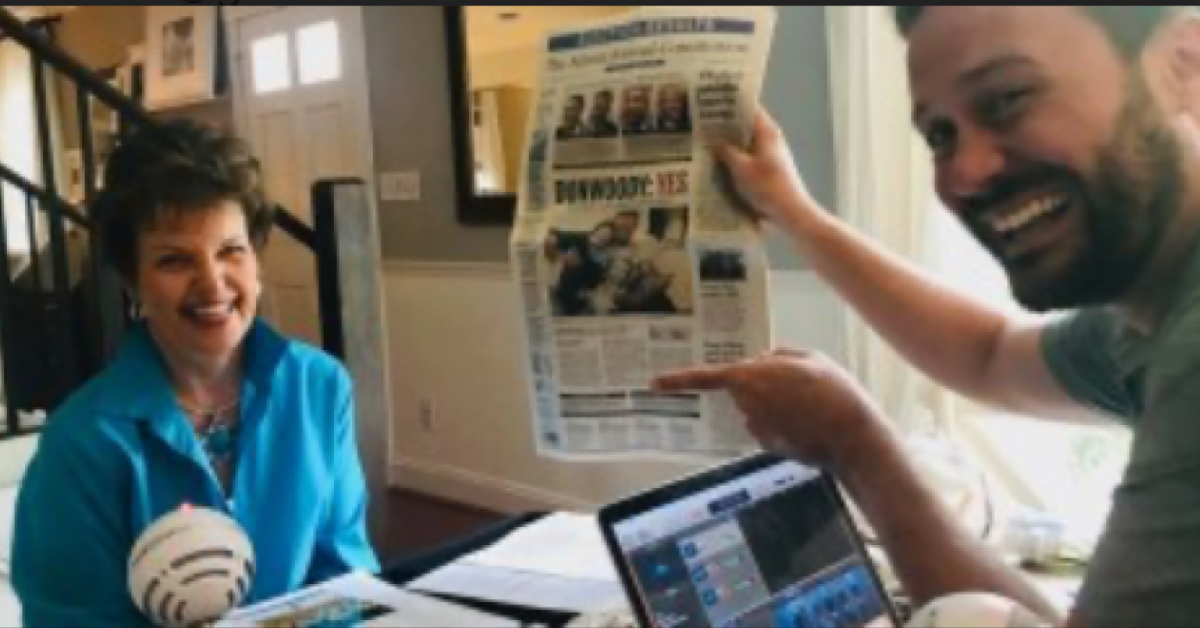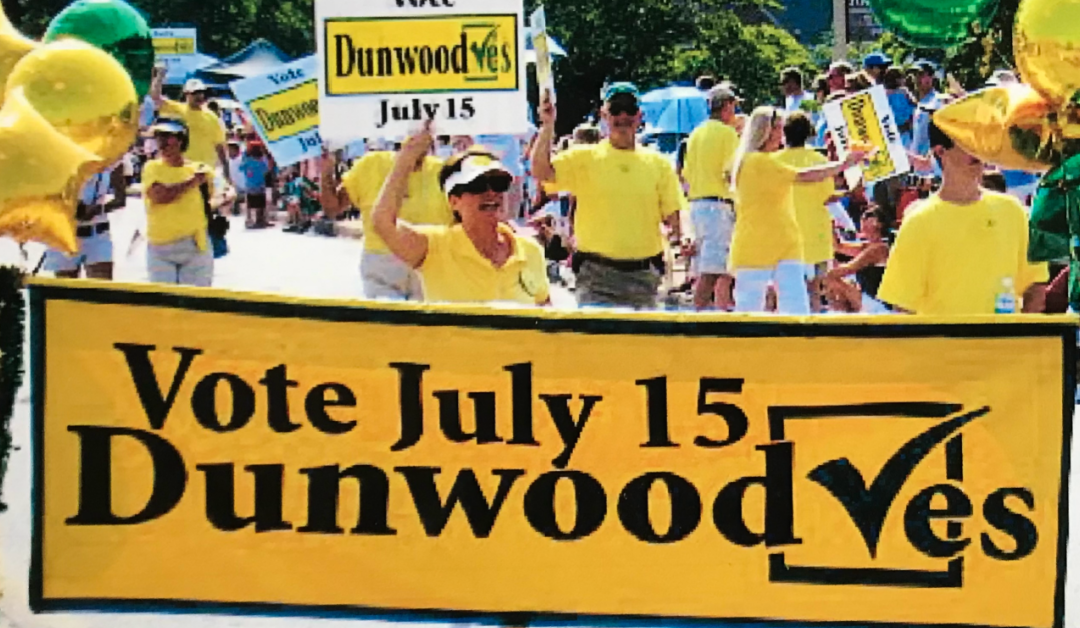When I first moved to Dunwoody, we didn’t know much about the city’s history or the story behind its incorporation. Honestly, I don’t even remember knowing that the city was a city. We started the What’s Up Dunwoody Podcast in early 2018, and quickly began hearing stories about the incorporation of the city. Everyone kept telling me about a woman named Bev Wingate, who was a driving force behind the city’s incorporation. I reached out, and Justin and I sat down with Bev for a conversation. This turned out being one of my favorite interviews. I broke it into a two-part podcast that we released in July, 2019.
Bev is lovingly known as the “Mother of Dunwoody.” She was honored by the city in 2020, when Mayor Lynn Deutsch proclaimed September 9th (her birthday) as Bev Wingate Day in the City of Dunwoody. Bev passed away on October 30th, 2023 after a 2-year battle with cancer. Each year, I love sharing the podcast on Bev Wingate Day. Here are the links to the podcast, and a shorter written summary of our conversation.

Dunwoody Before Incorporation
Dunwoody has always felt like a cohesive community, even before it officially became a city. Bev explained that, before incorporation, Dunwoody was part of unincorporated DeKalb County. “Because we had a post office and a zip code, a lot of people when they first moved here didn’t even realize we weren’t a city,” she said. The community was already established with schools, churches, and local landmarks, but many of the decisions about zoning and development were being made by the county.
One of the main catalysts for the push toward incorporation was the rapid development approved by DeKalb County in the 1990s. Bev mentioned that apartment complexes were being built at an alarming rate. “In just a five-year period, they authorized 2,300 more apartments,” she recalled. This was a major concern for residents, as it threatened to disrupt the balance between residential neighborhoods and commercial areas.
The Birth of Dunwoody Yes
As the zoning battles with DeKalb County intensified, Bev and other community leaders realized that something had to change. They formed a group called Citizens for Dunwoody, which later evolved into Dunwoody Yes, the campaign to incorporate the city. “Dunwoody as a community had been an entity long before, but we knew we had to take control if we wanted to protect it,” Bev explained.
One of the things that struck me during our conversation was how grassroots this effort was. Bev shared stories about organizing meetings, printing campaign materials at home, and even selling car magnets to raise funds for yard signs. “We didn’t have any money other than what was donated out of the pockets of two or three of us,” she laughed. Despite these challenges, the community rallied around the cause, and the momentum for incorporation grew.
Overcoming Opposition
Not everyone was on board with the idea of turning Dunwoody into a city. Some residents feared that incorporation would lead to higher taxes or that the numbers just wouldn’t add up. “Some people were scared; they thought the numbers wouldn’t work,” Bev said, referencing the small but vocal group of opponents. However, a turning point came when the Carl Vinson Institute of Government at the University of Georgia conducted a study that showed Dunwoody could be financially viable as an independent city. “That study gave us the legitimacy we needed,” Bev added.
Even with this validation, there were still hurdles to overcome. Bev talked about the challenges of getting the incorporation bill through the Georgia legislature. At one point, they thought the bill might die on the floor because many of their supporters had left to attend a reception with U.S. Senator Saxby Chambliss. “There was one picture of a senator frantically waving for them to come up and vote,” Bev recounted with a smile. In the end, the bill passed, and Dunwoody residents were given the chance to vote on cityhood.
The Vote and the Night Dunwoody Became a City
On July 15, 2008, the people of Dunwoody overwhelmingly voted in favor of becoming a city, with 81% of voters supporting incorporation. “That number blew us away,” Bev said. But the real celebration came on December 1, 2008, the night Dunwoody officially became a city.
At midnight, the newly formed Dunwoody Police Department rolled out in squad cars, marking the moment when the city truly took control of its own governance. “We stood there at midnight, waving to the police as they drove by. Somehow that made it even more real than the swearing-in of our first city council,” Bev shared. It was a powerful moment, one that symbolized the culmination of years of hard work and community effort.
A Legacy of Service
Bev Wingate didn’t just help incorporate the city; she continued to serve and shape Dunwoody long after. She was appointed to the Governor’s Commission, which helped oversee the transition from county services to city services. “We didn’t have the authority to sign contracts, but we were there to keep things moving,” she said, emphasizing the importance of a smooth transition.
Her involvement didn’t stop there. Bev played a key role in ensuring the city’s infrastructure needs were addressed, particularly when it came to police services, zoning, and paving—three of the main reasons Dunwoody became a city in the first place. She was proud of the work the city council and police chief accomplished in those early years. “We still today say Chief Billy Grogan did it with wide-eyed amazement and awe,” Bev said.
The Dunwoody We Know Today
As someone who moved to Dunwoody after incorporation, I’ve been able to see firsthand the impact of Bev’s work and the efforts of Dunwoody Yes. The city has grown and flourished, but it has also retained the small-town feel that makes it such a special place to live. Bev was quick to credit the volunteers and community members who worked alongside her. “Every piece of the puzzle was important,” she said. It was never just about a few leaders; it was about the entire community coming together to create something lasting.
Bev’s love for Dunwoody was evident in everything she did, and she always kept her focus on what was best for the community. “I never had a hidden agenda. My agenda was Dunwoody and anything that makes Dunwoody fly,” she said with a smile. Her dedication to the city she loved continues to inspire those of us who live here today.
Bev Wingate’s story is a testament to the power of community and the impact one person can have on the place they call home. Her legacy lives on in the streets, schools, and institutions of Dunwoody, and we are all better off because of her dedication and love for this city. As Dunwoody continues to grow, we can look back at Bev’s work as the foundation that made it all possible.
During the podcast, Bev mentioned many others who contributed to the incorporation of Dunwoody. She was a team player, and I know she would hate it if I didn't mention their names along with the story.
Ken Wright – Ken Wright became Dunwoody’s first mayor after the successful incorporation vote. He had previously served as president of the Dunwoody Homeowners Association (DHA), which acted as a quasi-government before the city’s formation. Bev admired his leadership and community involvement, saying he was a perfect fit to guide Dunwoody through its early years as a city.
Rob Augustine – As one of the leaders of Citizens for Dunwoody, Rob Augustine was instrumental in providing crucial information to the public about the benefits of incorporation. Bev worked closely with Rob, particularly during the campaign phase, ensuring that residents were well-informed and equipped to make a decision on cityhood.
Dan Weber – Dan Weber was the Georgia state senator who introduced the bill for Dunwoody’s incorporation in 2008. His legislative efforts were vital in getting the cityhood vote on the ballot. Bev credited Weber for having the vision and political savvy to push through the incorporation process during a time when zoning issues and rapid development were changing the community’s landscape.
Brian Anderson – An attorney deeply involved with Citizens for Dunwoody, Brian Anderson played a pivotal role in the legal and logistical aspects of the incorporation. Bev praised his expertise and dedication in ensuring that the incorporation effort adhered to legal frameworks and was well-positioned for success.
Bill Robinson – A representative of the Dunwoody Homeowners Association, Bill Robinson was one of the many volunteers who fought to preserve Dunwoody’s residential charm and manage growth. Bev worked alongside him in efforts to protect Dunwoody from unchecked development during the campaign for cityhood.
Adrian Bonser – Adrian Bonser was a dedicated community member who later became a Dunwoody city council member. She was heavily involved in the initial efforts to incorporate and went on to serve the city, helping to shape its policies and growth after incorporation.
Mike Davis – Mike Davis was part of the early incorporation team and went on to become a mayor of Dunwoody. Bev mentioned him as someone who contributed to the original campaign efforts and helped the city transition from unincorporated status to an independent municipality.
Tom Taylor – A crucial figure in the lobbying efforts, Tom Taylor worked alongside others like Dan Weber to push for cityhood in the Georgia legislature. He later became a state representative for the area and continued to support Dunwoody’s growth and governance in the years following incorporation.
Yvonne Williams – Yvonne Williams was the president of the Perimeter Community Improvement District (PCID), and her involvement with the Governor’s Commission helped ensure a smooth transition for Dunwoody. She represented the business community and played a key role in negotiating agreements with DeKalb County as the city took over local services.
Denny Shortal – Denny Shortal, who later served as mayor of Dunwoody, was a staunch supporter of incorporation from the beginning. He contributed to the incorporation process by supporting the campaign efforts and helped lay the groundwork for many of the city’s early infrastructure projects, such as paving and zoning initiatives.
These individuals formed a collaborative team that worked tirelessly to make Dunwoody’s incorporation a reality. Each brought unique skills and perspectives, which Bev emphasized as critical to the success of the movement.







